Contents
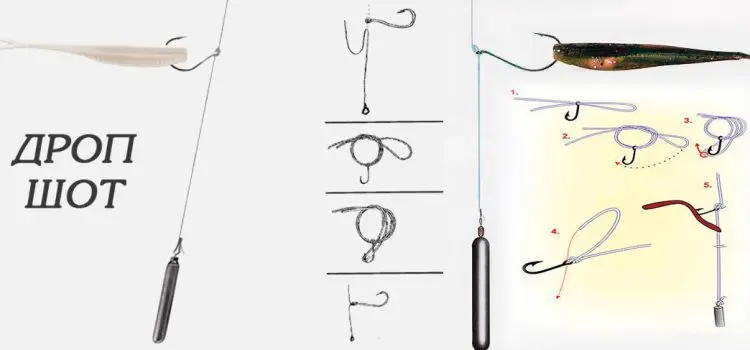
Such equipment is used for catching fish such as perch and zander. Its advantage lies in the fact that the bait is located next to the sinker. At the same time, the sinker is not weighed down, and the bait plays more naturally. Actually a snap Drop shot is one of the upgrades to the leash equipment.
Tackle
This versatile rig is applicable to various fishing conditions. It can be used for different types of rods and with different lengths. In this case, the main force is transmitted through a braided line, so the action of the rod does not play any role.
Selecting Drop Shot Rig Items
Despite the fact that such equipment can be mounted on any rod, there is still a limit on its length. Using rods with a length of less than 2,5 meters, it will be inconvenient to work with such equipment, since the bait will not be believable. At the same time, the action of the rod can be any, for example, a feeder rod with a very sensitive tip.
Fishing line
Monofilament fishing line is always used as a leash, moreover, in such a way that in the event of a hook, only the leash comes off.
Drop Shot rig
Hooks
For mounting Drop-shot, you can use both conventional hooks and offset ones. Silicone baits are attached to the hooks. The advantage of the offset is that you can mount a “non-hook” and safely catch in potentially dangerous places. Hooks can be fastened with any, but reliable knots. It is best to use hooks from well-known companies.
Sinker
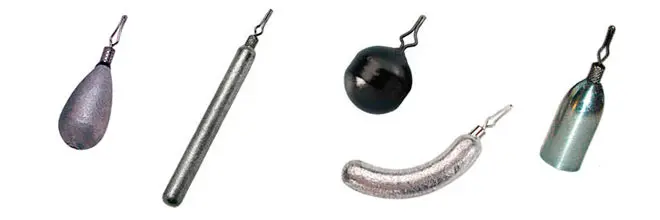
For Drop-shot rigs, special sinkers are produced, which are preferable to use. But this does not mean that other types of sinkers cannot be used, for example, the same “cheburashka” or the classic sinker of bottom gear. It all depends on the conditions of fishing, and if the topography or the nature of the bottom does not allow the use of conventional sinkers, then it is better to use the classic drop-shot. It is less prone to hooks, as it has a special shape. Such weights can be used to determine the nature and topography of the bottom.
Drop Shot Lures and Accessories
In such equipment, it is possible to use any bait, such as: vibrotail, twister, various worms, etc. The size of the lures is determined by the size of the hook, and the size of the hook depends on the expected size of the fish caught. Perch prefer lures 3-5 cm long. For fishing in the grass, it is better to use offsets. To make the bait look like a non-hook, the tip of the hook is hidden in a silicone bait.
Installation of equipment
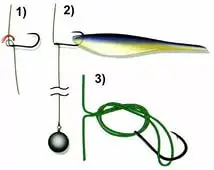 To mount such equipment, you need to stock up on a sinker in the form of a drop or in the form of a stick, as well as an ordinary hook or offset. The weight should have a neat shape without the slightest burr to minimize possible snags. Naturally, you can’t do without fishing line, with a diameter of 0,14 to 0,25 mm, depending on what kind of fish you plan to catch. For perch, this can be a line from 0,14 to 0,2 mm, and for catching more powerful fish, a line from 0,2 to 0,25 mm should be used.
To mount such equipment, you need to stock up on a sinker in the form of a drop or in the form of a stick, as well as an ordinary hook or offset. The weight should have a neat shape without the slightest burr to minimize possible snags. Naturally, you can’t do without fishing line, with a diameter of 0,14 to 0,25 mm, depending on what kind of fish you plan to catch. For perch, this can be a line from 0,14 to 0,2 mm, and for catching more powerful fish, a line from 0,2 to 0,25 mm should be used.
Sinker
For installation, you need to take about 1 meter of fishing line at one end, tie the sinker with any reliable knot. To make the hook impossible, the extra protruding end of the fishing line should be cut off as close to the knot as possible. Depending on how fast the flow is, the weight can be from 6 to 30 grams. The greater the current, the heavier the load must be used. When tying knots, it is advisable to moisten them, especially before tightening.
Hook and Knot Connection
Having measured 30-70 cm from the load, you can tie a hook. As mentioned above – it can be any type of hook at will and according to the possibilities. The hook is attached directly to the fishing line. Which node is better to use for this, you can find out on the Internet, where you can not only read, but also see in reality how this is done.
Node
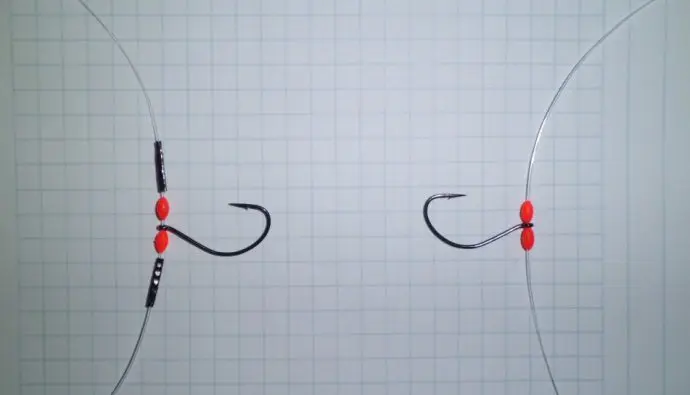
When tying a knot, there is one very important feature: after tying, the hook should look away from the main fishing line, and its tip should look towards the rod. This is very important, because otherwise it will catch on the main line and the real lure game will not work. The result is a leash with a sinker and a hook, about 1 meter long. It remains only to connect such a tackle with the main fishing line. This can be a loop-to-loop connection or using a carabiner with a swivel. This or that method has its pros and cons: when using a carabiner, it is possible to quickly change the equipment, and when using the loop-to-loop method, such a connection is less alarming for the fish.
Drop Shot Fishing Technique
Drop-shot rig is used as an active type of fishing. The technique of using such equipment helps to activate the actions of the fish, provoking it to attack. It is better to fish from a boat, as this makes it possible for such equipment to be one hundred percent.
Tackle is thrown at a distance of up to 20-25 meters. After the load reaches the bottom, you can start wiring. The wiring is not like a jig and has its own characteristics. The tackle is twitching with a fishing rod and at these moments the slack of the fishing line is removed by winding the reel. In this case, the movements should not be sharp and strong. As soon as the tackle approaches the boat, you can play with the bait using the current. At the same time, the load constantly hits the bottom of the reservoir, raising silt, and this can certainly interest any, even very sleepy fish.
Animation methods
Drop-shot equipment can be mounted on a regular spinning rod, which is used for jigging. To do this, to the end of the main fishing line, a monofilament leash should be fixed. A load is attached to the end of the leash, weighing 30-35 grams, but first of all you need to tie a hook. Special hooks are produced for Drop-shot rigging, but many fishermen use offset hooks. The hook is tied so that the tip of the hook looks up. In such cases, the Albright knot is used.
The load has the shape of a “banana”, which allows you to minimize hooks, since the load is constantly at the bottom and, as it were, “drags” along it with small jumps. This is the peculiarity of using such equipment.
Scope of equipment Drop-shot
Such equipment gives very good results in places where the use of jig wiring is problematic, in all other cases, it is no better than the widespread jig, although certain advantages are observed here as well. The fact is that the use of such equipment has its own specifics: for greater efficiency, it is necessary that the equipment is constantly in an upright position, which makes it possible to use the current of the reservoir for its play. This cannot be done with a classic jig. If we compare all the pluses, then the Drop-shot rig can be an order of magnitude more catchy than a jig.

It is effective to use it when fishing holes, as well as snarled places, especially those where snags are at the bottom of the reservoir and are practically invisible. When casting jig baits, this will certainly lead to hooks. Drop-shot tackle, due to its specificity, is able to “step over” such blockages.
With certain skills in using such equipment, you can count on effective fishing, and it will not be limited to perch and zander. It is quite possible that the pike will not survive such a game and will attack the bait. When mounting the equipment, this option should also be taken into account, which means that measures must be taken to ensure that it does not bite the main fishing line of the leash.
Disadvantages of Drop Shot
The disadvantages of such equipment are minimal, but significant. Firstly, it does not take into account the fact that in any reservoir, along with other types of fish, there is also a toothy predator, which sometimes bites on the lead material, so it is somewhat unfinished. And secondly, handling such gear requires great skills. The main condition for its effectiveness is the vertical position of the equipment, which is very difficult to maintain in the current. In order for the tackle to be constantly in this position, a certain depth is needed. Therefore, at shallow depths and shallows, it simply does not make sense to use it.
Advantages of a Drop Shot
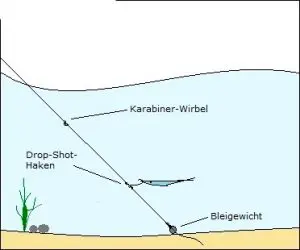 Like all other rigs, the drop-shot system has not only disadvantages, but also a number of advantages in relation to other types of gear. Firstly, the bait is constantly at the same depth, regardless of the current and bottom topography. Secondly, the active work of gear can provoke even the laziest fish to attack. This is due to the fact that the cargo is constantly in contact with the bottom, raising clouds of turbidity, and the fish instantly rushes into the area, knowing that there is an opportunity to catch some kind of bug. In this combination of excitement and curiosity, she may be on the hook. In fishing for suspicious places or places with aquatic vegetation, such equipment has no equal, especially if offset hooks are used. The hooks are also minimal because the lure is very close to the line. In other words, she does not have a leader, 15-20 cm long, as when using, for example, bottom gear, where the leader and its length play a major role in her catchability. Since there is no leash, there is nothing to cling to.
Like all other rigs, the drop-shot system has not only disadvantages, but also a number of advantages in relation to other types of gear. Firstly, the bait is constantly at the same depth, regardless of the current and bottom topography. Secondly, the active work of gear can provoke even the laziest fish to attack. This is due to the fact that the cargo is constantly in contact with the bottom, raising clouds of turbidity, and the fish instantly rushes into the area, knowing that there is an opportunity to catch some kind of bug. In this combination of excitement and curiosity, she may be on the hook. In fishing for suspicious places or places with aquatic vegetation, such equipment has no equal, especially if offset hooks are used. The hooks are also minimal because the lure is very close to the line. In other words, she does not have a leader, 15-20 cm long, as when using, for example, bottom gear, where the leader and its length play a major role in her catchability. Since there is no leash, there is nothing to cling to.
Conclusion
The design, equipment allows you to use it both in the course of any force, and in stagnant water. We can safely say that the tackle is universal and allows you to catch serious depths. At the same time, it is possible to experiment with the weight of the sinker, which makes it possible to determine the best option for tackle for any fishing conditions.
And yet, for such tackle, it makes sense to select both a fishing line and a rod, depending on the weight of the sinker, as well as the nature of the reservoir. If you plan to cast far, especially from the shore, and even more so with steep banks, then it is better to use braided line as the main line, and mount the equipment on a meter-long piece of monofilament line of a suitable diameter so that you do not have to tear the braid when hooking. If fishing is carried out on a current where it is desirable to use a heavy load, it is better to use a powerful feeder rod with a sensitive tip. If you use an ordinary spinning rod with the appropriate test (about 50-70g), it will be very difficult to identify bites, especially at long distances.
The Drop-shot rig, in its specifics of application, is somewhat similar to the “Tyrolean wand”. Its basis is a load of a special design, which, getting into the water and sinking to the bottom, always takes a vertical position, which reduces the risk of hooking several times. However, there are some differences in the wiring. These differences lie in the fact that the “Tyrolean wand” is not carried out with the help of a fishing line and a reel, but moves along the river, carried along by the current. At the same time, the load “drags” along the bottom, raising a cloud of turbidity, and the bait on leashes rises and keeps horizontally, due to the current. The Tyrolean Wand, like the Drop Shot, must be kept upright, only then will it work effectively.









